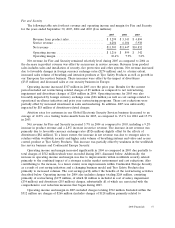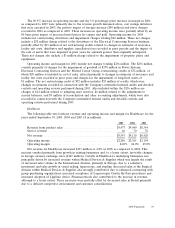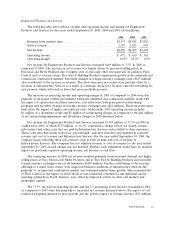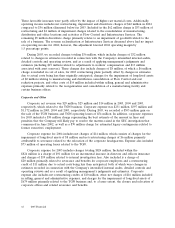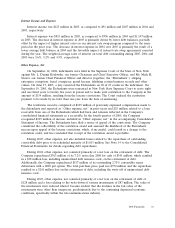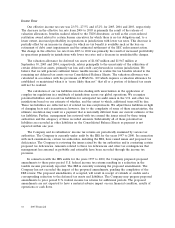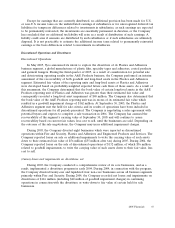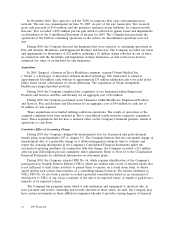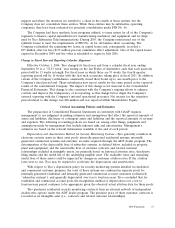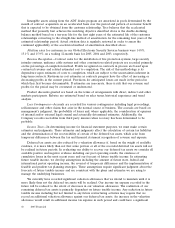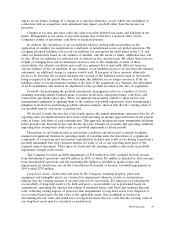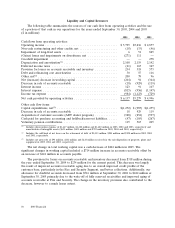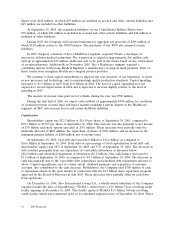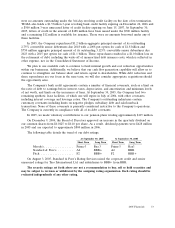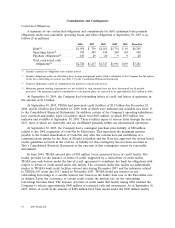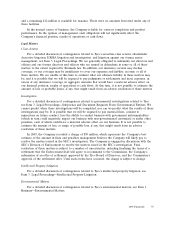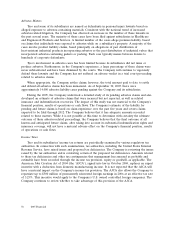ADT 2005 Annual Report Download - page 123
Download and view the complete annual report
Please find page 123 of the 2005 ADT annual report below. You can navigate through the pages in the report by either clicking on the pages listed below, or by using the keyword search tool below to find specific information within the annual report.support and where the investors are entitled to a share in the results of those entities, but the
Company does not consolidate these entities. While these entities may be substantive operating
companies, they have been evaluated for potential consolidation under FIN No. 46.
The Company had three synthetic lease programs utilized, to some extent, by all of the Company’s
segments to finance capital expenditures for manufacturing machinery and equipment and for ships
used by Tyco Submarine Telecommunications. During 2003, the Company restructured one of the
synthetic leases to meet the requirements of FIN No. 46 for off-balance sheet accounting. The
Company reclassified the remaining two leases as capital leases and, consequently, recorded a
$75 million after-tax loss ($115 million pre-tax) cumulative effect adjustment. One of the capital leases
expired in December 2004 and the other is scheduled to expire in July 2006.
Change in Fiscal Year and Reporting Calendar Alignment
Effective October 1, 2004, Tyco changed its fiscal year end from a calendar fiscal year ending
September 30 to a ‘‘52-53 week’’ year ending on the last Friday of September, such that each quarterly
period will be 13 weeks in length. For fiscal years in which there are 53 weeks, the fourth quarter
reporting period will be 14 weeks, with the first such occurrence taking place in fiscal 2011. In addition,
certain of the Company’s subsidiaries consistently closed their books up to one month prior to the
Company’s fiscal period end. These subsidiaries now report results for the same period as the reported
results of the consolidated Company. The impact of this change is not material to the Consolidated
Financial Statements. This change is also consistent with the Company’s ongoing efforts to enhance
controls and improve the transparency of its reporting, as this change better aligns the Company’s
external reporting with the Company’s internal operational processes. Net income for the transition
period related to this change was $26 million and was reported within Shareholders’ Equity.
Critical Accounting Policies and Estimates
The preparation of Consolidated Financial Statements in conformity with GAAP requires
management to use judgment in making estimates and assumptions that affect the reported amounts of
assets and liabilities, disclosure of contingent assets and liabilities and the reported amounts of revenue
and expenses. The following accounting policies are based on, among other things, judgments and
assumptions made by management that include inherent risks and uncertainties. Management’s
estimates are based on the relevant information available at the end of each period.
Depreciation and Amortization Method for Security Monitoring Systems—Tyco generally considers its
electronic security assets in three asset pools: internally generated residential systems, internally
generated commercial systems and customer accounts acquired through the ADT dealer program. The
determination of the depreciable lives of subscriber systems, as defined below, included in property,
plant and equipment, and the amortizable lives of customer contracts and related customer
relationships included in intangible assets, are primarily based on historical attrition rates, third-party
lifing studies and the useful life of the underlying tangible asset. The realizable value and remaining
useful lives of these assets could be impacted by changes in customer attrition rates. If the attrition
rates were to rise, Tyco may be required to accelerate the depreciation and amortization.
With respect to Tyco’s depreciation policy for security monitoring systems installed in residential
and commercial customer premises, the costs of these systems are combined in separate pools for
internally generated residential and internally generated commercial account customers (collectively
‘‘subscriber systems’’), and generally depreciated over ten to fourteen years. Tyco concluded that for
residential and commercial account pools the straight-line method of depreciation over a ten to
fourteen-year period continues to be appropriate given the observed actual attrition data for these pools.
Tyco purchases residential security monitoring contracts from an external network of independent
dealers who operate under the ADT dealer program. The purchase price of these customer contracts is
recorded as an intangible asset (i.e., contracts and related customer relationships).
2005 Financials 47


